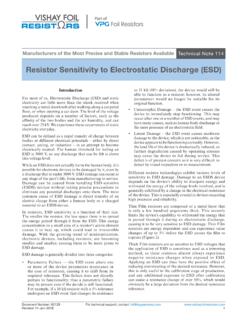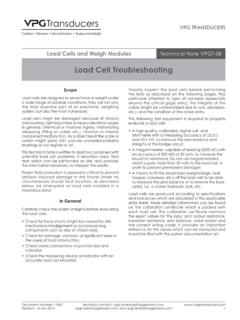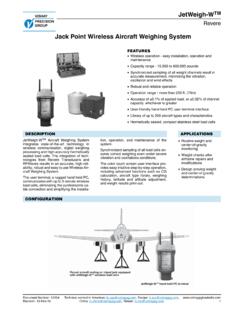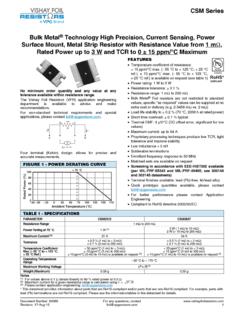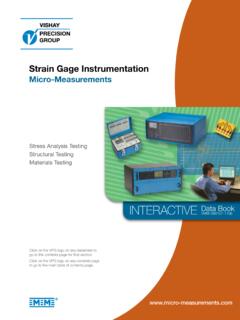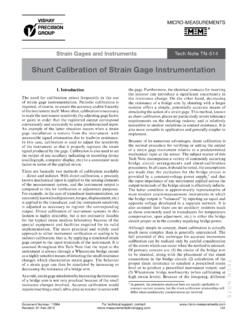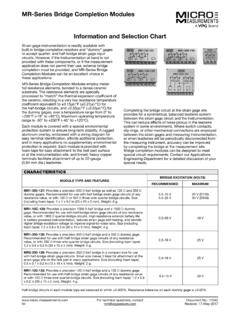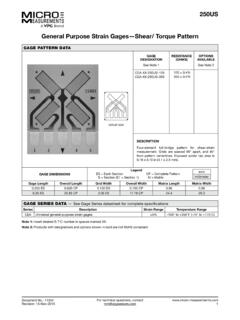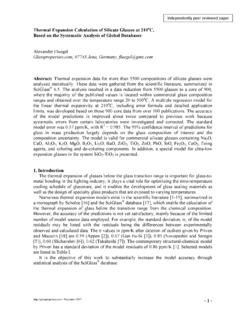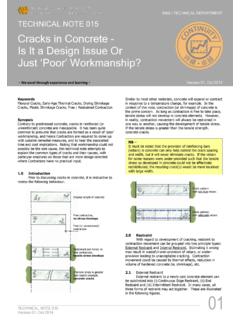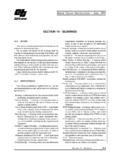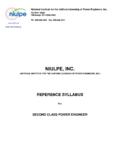Transcription of Strain Gage Thermal Output and Gage Factor …
1 Tech Note TN-504-1 MICRO-MEASUREMENTSS train gage Thermal Output and gage Factor Variation with TemperatureStrain Gages and InstrumentsFor technical support, contact Number: 11054 Revision IntroductionIdeally, a Strain gage bonded to a test part would respond only to the applied Strain in the part, and be unaffected by other variables in the environment. Unfortunately, the resistance Strain gage , in common with all other sensors, is somewhat less than perfect. The electrical resistance of the Strain gage varies not only with Strain , but with temperature as well. In addition, the relationship between Strain and resistance change, the gage Factor , itself varies with temperature.
2 These deviations from ideal behavior can be important under certain circumstances, and can cause significant errors if not properly accounted for. When the underlying phenomena are thoroughly understood, however, the errors can be controlled or virtually eliminated by compensation or Section of this Tech Note, Thermal Output (sometimes referred to as temperature-induced apparent Strain ) is defined, and the causes of this effect are described. Typical magnitudes of the Thermal Output are then given, followed by the commonly used methods for compensation and correction. Section treats gage Factor variation with temperature in a similar but briefer manner since this error source is generally much less significant.
3 Methods for the simultaneous correction of both Thermal Output and gage Factor errors are given in Section , accompanied by numerical Thermal OutputOnce an installed Strain gage is connected to a Strain indicator and the instrument balanced, a subsequent change in the temperature of the gage installation will normally produce a resistance change in the gage . This temperature-induced resistance change is independent of, and unrelated to, the mechanical (stress-induced) Strain in the test object to which the Strain gage is bonded. It is purely due to temperature change, and is thus called the Thermal Output of the Output is potentially the most serious error source in the practice of static Strain measurement with Strain gages.
4 In fact, when measuring strains at temperatures remote from room temperature (or from the initial balance temperature of the gage circuit), the error due to Thermal Output , if not controlled, can be much greater than the magnitude of the Strain to be measured. At any temperature, or in any temperature range, this error source requires careful consideration; and it is usually necessary to either provide compensation for Thermal Output or correct the Strain measurements for its Output is caused by two concurrent and algebraically additive effects in the Strain gage installation. First, the electrical resistivity of the grid conductor is somewhat temperature dependent; and, as a result, the gage resistance varies with temperature.
5 The second contribution to Thermal Output is due to the differential Thermal expansion between the grid conductor and the test part or substrate material to which the gage is bonded. with temperature change, the substrate expands or contracts; and, since the Strain gage is firmly bonded to the substrate, the gage grid is forced to undergo the same expansion or contraction. To the extent that the Thermal expansion coefficient of the grid differs from that of the substrate, the grid is mechanically strained in conforming to the free expansion or contraction of the substrate. Because the grid is, by design, Strain sensitive, the gage exhibits a resistance change proportional to the differential of the two thermally induced resistance changes may be either positive or negative in sign with respect to that of the temperature change, and the net Thermal Output of the Strain gage is the algebraic sum of these.
6 Thus, expressed in terms of unit resistance change, the Thermal Output becomes: RRFKKTTOGGttSG0011 =++ () / (1) where, in consistent units: RRTO0 /= unit change in resistance from the initial reference resistance, R0, caused by change in temperature resulting in Thermal Output . G = temperature coefficient of resistance of the grid conductor. FG = gage Factor of the Strain gage . Kt = transverse sensitivity of the Strain gage . 0 = Poisson s ratio ( ) of the standard test material used in calibrating the gage for its gage Factor . In this Tech Note, the gage Factor of the Strain gage is identified as FG, to distinguish it from the gage Factor setting of the measuring instrument, denoted here by FI.
7 This distinction is important, since the gage Factor setting of the instrument may sometimes, as a matter of convenience or utility, be different from that of the technical questions, Note TN-504-1 Document Number: 11054 Revision: gage Thermal Output and gage Factor Variation with Temperature( S G) = difference in Thermal expansion coefficients of substrate and grid, respectively. T = temperature change from an arbitrary initial reference correction Factor for transverse sensitivity [(1 + Kt)/ (1 0Kt)] is included in Equation (1) to account for the fact that the Strain in the gage grid due to differential Thermal expansion is equal-biaxial, while the gage Factor , FG, refers to the Strain sensitivity as calibrated in a uniaxial stress state, with a principal Strain ratio of 1/( ).
8 It should not be assumed from the form of Equation (1) that the Thermal Output is linear with temperature change, because all of the coefficients within the brackets are themselves functions of temperature. The equation clearly demonstrates, however, that Thermal Output depends not only on the nature of the Strain gage , but also on the material to which the gage is bonded. Because of this, Thermal Output data are meaningful only when referred to a particular type of Strain gage , bonded to a specified substrate convenience in correcting measured Strain data for thermally induced resistance changes, the Thermal Output of the gage is usually expressed in Strain units. Thus, dividing Equation (1) by the gage Factor setting of the instrument, TOTOIGGttRRFFKK//= =++ 0011 SSGITF () (2) where: T/O = Thermal Output in Strain units; that is, the Strain magnitude registered by a Strain indi- cator ( with a gage Factor setting of FI), when the gage installation is subjected to a tem- perature change, T, under conditions of free Thermal expansion for the measuring stress-induced strains at a temperature different from the initial balance temperature, the Thermal Output from Equation (2) is superimposed on the gage Output due to mechanical Strain , causing the measurement to be in error by that amount.
9 Many factors affect the Thermal Output of Strain gages. Some of the more important are: test specimen material and shape, grid alloy and lot, gage series and pattern, transverse sensitivity of the gage , bonding and encapsulating materials, and installation procedures. It is never possible for Micro-Measurements to predict exactly what the Thermal Output of any gage will be when the user has bonded it to a test structure. Even in cases where applications involve the same material as that used by Micro-Measurements in its tests, differences can be expected since structural materials vary in Thermal expansion characteristics from lot to lot. The best practice is always to evaluate one or more gages under Thermal conditions as nearly like those to be encountered in the testing program as 1 shows the variation of Thermal Output with temperature for a variety of Strain gage alloys bonded to steel.
10 These data are illustrative only, and not for use in making corrections. It should be noted, in fact, that the curves for constantan and Karma are for non-self-temperature-compensated alloys. with self-temperature compensation (Section ), as employed in Micro-Measurements Strain gages, the Thermal Output characteristics of these alloys are adjusted to minimize the error over the normal range of working indicated by Figure 1, the errors due to Thermal Output can become extremely large as temperatures deviate from the arbitrary reference temperature (ordinarily, room temperature) with respect to which the Thermal Output is measured. The illustration shows distinctly the necessity for compensation or correction if accurate static Strain measurements are to be made in an environment involving temperature respect to the latter statement, it should be remarked that if it is feasible to bring the gaged test part to the test temperature in the test environment, maintaining the test part completely free of mechanically or thermally induced stresses, 0 50+50+100+150+200+250+4000+1000+2000+300 00 1000 2000 3000 4000 1000+100+200+300 Thermal Output (FI = )+400+500 TEMPERATURE CTEMPERATURE FALLOYS BONDED TOSTEEL SPECIMENCONSTANTAN(FULL HARD)KARMA (FULL HARD)NICHROME VISOELASTIC+24 C+75 FFigure 1.
